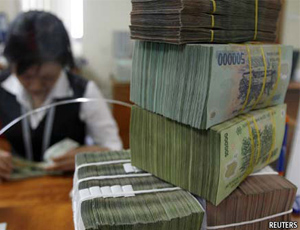Vietnam’s Retail Banks Seek to Entice New Customers
 HCMC – For years, the main source of income for banks in Vietnam has come from lending to businesses, but increasingly many banks are making a large proportion of their revenues off of the retail banking sector. This is spurring a wave of innovation throughout this sector as banks seek to entice new customers and provide new payment methods. Additionally, as internet penetration increases throughout the country, banks are looking for the best ways to benefit from the e-commerce revolution that is taking place.
HCMC – For years, the main source of income for banks in Vietnam has come from lending to businesses, but increasingly many banks are making a large proportion of their revenues off of the retail banking sector. This is spurring a wave of innovation throughout this sector as banks seek to entice new customers and provide new payment methods. Additionally, as internet penetration increases throughout the country, banks are looking for the best ways to benefit from the e-commerce revolution that is taking place.
 RELATED: Dezan Shira & Associates’ Global Services
RELATED: Dezan Shira & Associates’ Global Services
Some of the key local banks that are providing services for Vietnam’s burgeoning middle class include Techcombank, Maritime Bank and VPBank. As they have sought to grow their retail banking arms, these banks have employed hundreds of workers to contact potential customers and inform them of their new services.
In particular, the banks are working to develop new card services and are pushing their customers to develop new consumer habits, such as making payments via cards, especially for repeat purchases like food.
RELATED: Vietnam Online – Understanding Vietnam’s E-commerce Market
Foreign banks are also increasing their presence in Vietnam’s retail banking sector. These banks are benefiting from their perceived trustworthiness and professionalism as compared to Vietnam’s nascent banking industry. Banks such as HSBC and ANZ have identified Vietnam as a key market for their retail banking sectors.
RELATED: Vietnam To Open Up Banking System
However, as retail banking has increased its presence within the country, there has been a sharp increase in the number of complaints about service quality, particularly among local banks. Additionally, the number of people who have been listed as having bad debts has increased as well. The State Bank of Vietnam’s Credit Information Center (CIC) has reported that, over the last year, it has seen an increase of two to three times in the number of appeals that have been filed by clients seeking to have their names removed from the CIC’s blacklist of those with bad debts.
There are two main reasons for this surge in complaints and bad debt: many bank workers are still not operating at a professional level; and many Vietnamese are not well educated about the services that retail banking operations provide to their clients.
No more cash
As the economy grows and people continue moving away from favoring cash payments, card payment channels will see strong growth. During the period 2009 to 2013, the amount of card transactions doubled. During the same period, the number of cards in circulation increased from 21.7 million to 67.8 million. Transaction value also increased, moving from US$21.4 billion to US$62.8 billion. By 2018 it is estimated that Vietnam will account for US$106.5 billion in transaction value.
A number of factors have fueled this growth, these include:
- An increase in the number of middle-class families;
- The increased need for access to credit;
- Changes in consumer spending habits;
- The easy approval of credit cards;
- The issuing of customized credit cards for diverse customer segments (ex. high-income, youth, females and travelers).
Companies such as MasterCard are paying particular attention to Vietnam. They believe that the country has a good technological infrastructure which has laid the groundwork for the creation of a new payment technology for the mobile market. E-commerce is growing in popularity within the country and banks are keen to cash in on this growth industry. The key area where banks can have an effect is in creating effective payment solutions for customers to purchase products online.
RELATED: Credit Institutions in Vietnam Now Offering Foreign Currency Loans
As a result of the increase in the number of Vietnamese with bank accounts, there is also expected to be an accompanying increase in the number of e-payment methods. These methods include e-wallets and e-cards.
One of the key challenges for banks is how to attract young people to use their services. Vietnam is on the cusp of a demographic dividend that will see the number of new young entrants into the workforce soar over the coming years. This is an increasingly tech savvy and important customer segment for the banks and they will have to be approached in new ways via the internet, e-banking and mobile devices. Additionally, the quality and type of services provided by the banks will have to be improved and expanded upon in order to meet the needs of their potential customers.
RELATED: Foreign Competition Shakes Up Vietnam’s E-Commerce Market
Reaching their customers via the internet and creating online payment solutions is increasingly important for both banks and businesses in general in Vietnam. The country has an online population of 35 million (39 percent of the total population), 73 percent of internet users are under 35 years of age, and 92 percent of these users go online every day. Vietnam’s E-Commerce and Information Technology Agency (VECITA) predicts that by 2015 up to 50 percent of Vietnam’s population will be online and will be spending US$150 per capita on e-commerce purchases.
Vietnam’s retail banking industry is still in its infancy, but many banks have already realized the growth potential in this dynamic market. When combined with the predicted increase in size of the country’s middle class and the growth in e-commerce over the coming years, Vietnam is clearly a key market to be in for banks and businesses interested in long-term growth.
Asia Briefing Ltd. is a subsidiary of Dezan Shira & Associates. Dezan Shira is a specialist foreign direct investment practice, providing corporate establishment, business advisory, tax advisory and compliance, accounting, payroll, due diligence and financial review services to multinationals investing in China, Hong Kong, India, Vietnam, Singapore and the rest of ASEAN. For further information, please email vietnam@dezshira.com or visit www.dezshira.com.
Stay up to date with the latest business and investment trends in Asia by subscribing to our complimentary update service featuring news, commentary and regulatory insight.
Related Reading
 E-Commerce Across Asia: Trends and Developments 2014
E-Commerce Across Asia: Trends and Developments 2014
In this issue of Asia Briefing Magazine, we provide a comprehensive overview of e-commerce trends across the Asia-Pacific region with a focus on developing markets in Southeast Asia. In addition to analyzing macro-level economic and development indicators that signal the potential for region-wide growth, we explore several rapidly growing markets in-depth while highlighting opportunities for investment in each.
 Developing Your Sourcing Strategy for Vietnam
Developing Your Sourcing Strategy for Vietnam
In this issue of Vietnam Briefing Magazine, we outline the various sourcing models available for foreign investors – representative offices, service companies and trading companies – and discuss how to decide which structure best suits the sourcing needs of your business.
Ho Chi Minh City Cracks Down on Work Permits
Choosing the Right Sourcing Model in Vietnam
China and Hong Kong Increase Investment in Vietnam
Vietnam and Myanmar Sign MoU to Strengthen Mutual Cooperation in the Banking Sector
- Previous Article Hi-Tech Parks and New Urban Areas Slow to Attract Investment in HCMC
- Next Article Vietnam Airlines IPO to Finally Go Ahead

































